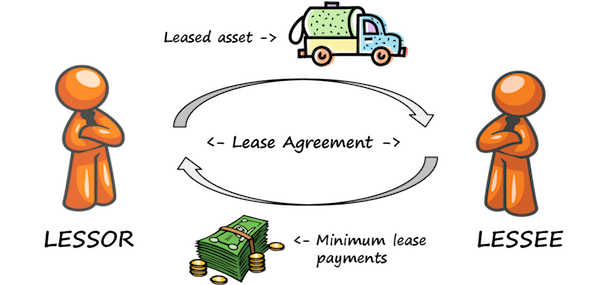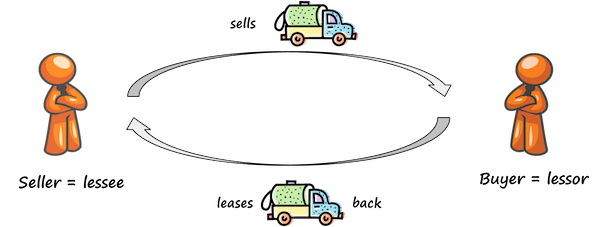IAS 17 Leases
IAS 17 Leases deals with the accounting and financial reporting of the very common business transaction—lease. Leases are the great example of “off-balance sheet” financing if not recorded properly in the financial statements.
In the past, many companies used to hide their finance lease liabilities and they reported all lease payments directly to profit or loss when paid. So no real picture of the transaction was shown.
Therefore, standard IAS 17 was issued in 1982 to tackle this problem. Let’s take a look.
UPDATE 2018: Please note that the standard IFRS 16 Leases will be effective for the periods starting on or after 1 January 2019 and IAS 17 will become superseded. I leave this article here for your information.
Classification of leases
Types of Leases
A lease is an agreement whereby lessor conveys to the lessee in return for a payment or series of payments (minimum lease payments) right to use an asset for the agreed period of time (lease term).
The lease relationship is illustrated in the following picture:

There are 2 types of leases defined in IAS 17:
- A finance lease is a lease that transfers substantially all the risks and rewards incidental to ownership of an asset. Legal title may or may not eventually be transferred.
- An operating lease is a lease other than a finance lease.
The classification of leases has to be performed at the inception of the lease, before recognizing any amounts related to the lease in the financial statements.
Situations and Indicators of Finance Lease
IAS 17 outlines examples of situations that would normally lead to a lease being classified as a finance lease:
- The lease transfers ownership of the asset to the lessee by the end of the lease term.
- The lessee has the option to purchase the asset at a price that is expected to be sufficiently lower than the fair value at the date of the option exercisability. It is reasonably certain, at the inception of the lease, that the option will be exercised.
- The lease term is for the major part of the economic life of the asset even if the title is not transferred.
- At the inception of the lease the present value of the minimum lease payments amounts to at least substantially all of the fair value of the leased asset.
- The leased assets are of such a specialized nature that only the lessee can use them without major modifications.
IAS 17 also lists 3 indicators that could also lead to lease being classified as a finance, but those are not always conclusive:
- If the lessee is entitled to cancel the lease, the lessor’s losses associated with the cancellation are borne by the lessee.
- Gains or losses from fluctuations in the fair value of the residual fall to the lessee (for example, by means of a rebate of lease payments).
- The lessee has the ability to continue to lease for a secondary period at a rent that is substantially lower than market rent.
Lease of Land and Building
When a lease includes both land and building elements, then the classification of each element as a finance lease or an operating lease shall be assessed separately.
Land has an indefinite economic life and therefore the land element is normally classified as an operating lease (unless legal title is expected to pass to the lessee by the end of the lease term).
The minimum lease payments are allocated between the land and the buildings element in proportion to the relative fair values of the leasehold interests in the land and building elements at the inception of the lease.
Leases in the Financial Statements of Lessees
Finance Lease
Initial Recognition
At the commencement of the lease term, lessee should recognize an asset and a lease liability at the lower of the fair value of the asset and the present value of the minimum lease payments.
The discount rate for calculating the present value of the minimum payments is the interest rate implicit in the lease.
The accounting entry is as follows:

Subsequent Measurement
There are 2 things to take care about after initial recognition:
- Minimum lease payments should be apportioned between the finance charge (interest) and the reduction of the outstanding lease liability.The finance charge should be allocated so as to produce a constant periodic rate of interest (interest rate implicit in the lease) on the remaining balance sheet liability. In practice, actuarial method is used a lot to work out the allocation.
The basic accounting entry of minimum lease payment paid to the lessor is as follows:

- Lessee should charge the depreciation expense related to the assets held under finance leases.
Operating Lease
Lessee should recognize the lease payments as an expense in the profit or loss over the lease term on a straight-line basis, unless another systematic basis is more representative of the time pattern of the user’s benefit.
Leases in the Financial Statements of Lessors
Finance Lease
Initial Recognition
At the commencement of the lease term, lessor should recognize lease receivable in his statement of financial position. The amount of the receivable should be equal to net investment in the lease.
Net investment in the lease equals to gross investment in the lease (minimum lease payments receivable by the lessor under the finance lease + any unguaranteed residual value accruing to the lessor) discounted by the interest rate implicit in the lease.
The accounting entry is to debit Lease Receivable and credit Property, plant and equipment (sometimes directly cash).
If lessor incurs any direct and incremental costs in negotiating leases, those must be recognized over the lease term and not to the expenses when incurred.
Subsequent Measurement
The lessor should split minimum payments received into finance income and reduction of the lease receivable. Finance income shall be recognized based on a pattern reflecting constant periodic rate of return on the lessor’s net investment in the lease.
The accounting entry is as follows:

Manufacturers or dealer lessor
Manufacturers or dealer lessor should recognize profit or loss from sale in the same period as they would for an outright sale. If artificially low rates of interest are charged, selling profit should be restricted to that which would apply if a commercial rate of interest were charged.
Costs incurred by manufacturers or dealer lessor in negotiating and arranging the lease shall be recognized as an expense when selling profit is recognized.
Operating Lease
As under the operating lease the risks and rewards of ownership do NOT transfer from lessor to lessee, lessor keeps recognizing the leased asset in his statement of financial position.
Lease income from operating leases shall be recognized as an income on a straight-line basis over the lease term, unless another systematic basis is more appropriate.
Sale and Leaseback Transactions
A sale and leaseback transaction involves the sale of an asset and the leasing the same asset back. In this situation, a seller becomes a lessee and a buyer becomes a lessor. This is illustrated in the following scheme:

Accounting treatment of sale and leaseback transactions depends on the character of the resulting lease.
Sale and Leaseback with Finance Lease
If the resulting lease is a finance lease, then in fact, the transaction is a loan securitized by the leased asset and seller / lessee keeps recognizing the asset. Any excess of proceeds over the carrying amount of the leased asset is deferred and amortized over the lease term.
Sale and Leaseback with Operating Lease
If the resulting lease is an operating lease, then a seller/lessee derecognizes the asset and a buyer/lessor recognizes the asset. Further accounting treatment depends on the sale price:
- f the sale price is close to asset’s fair value, then the profit or loss from sale should be recognized immediately.
- If the sale price is below asset’s fair value, then it is necessary to check the rental payments. If the future payments are below market price, then the loss from the sale of asset should be amortized over the period of use. If the future payments are close to market rentals, then the loss from the sale of asset should be recognized immediately.
- If the sale price is above fair value, then the excess over fair value or “profit from sale” should be deferred and amortized over the period of use.
Disclosures
IAS 17 prescribes a full load of disclosures for every type of the lease.
Except for general descriptions of the lease arrangements and other basic information about finance leases, both lessors and lessees are required to present reconciliation of future minimum lease payments (gross investment in the lease for the lessor) and their present value according to the period when they are due: not later than 1 year, later than 1 year and not later than 5 years; later than 5 years.
The same applies to operating leases, however, here both lessors and lessees are required to present the future minimum lease payments under non-cancellable operating leases in the aggregate and for each of the following periods: not later than 1 year, later than 1 year and not later than 5 years; later than 5 years.
Please check out IAS 17 in the following video:
JOIN OUR FREE NEWSLETTER AND GET
report "Top 7 IFRS Mistakes" + free IFRS mini-course
Please check your inbox to confirm your subscription.
Recent Comments
- mahima on IAS 23 Borrowing Costs Explained (2025) + Free Checklist & Video
- Albert on Accounting for gain or loss on sale of shares classified at FVOCI
- Chris Kechagias on IFRS S1: What, How, Where, How much it costs
- atik on How to calculate deferred tax with step-by-step example (IAS 12)
- Stan on IFRS 9 Hedge accounting example: why and how to do it
Categories
- Accounting Policies and Estimates (14)
- Consolidation and Groups (25)
- Current Assets (21)
- Financial Instruments (56)
- Financial Statements (54)
- Foreign Currency (9)
- IFRS Videos (74)
- Insurance (3)
- Most popular (7)
- Non-current Assets (56)
- Other Topics (15)
- Provisions and Other Liabilities (46)
- Revenue Recognition (27)
- Uncategorized (1)





On 1st January, 2018, a company entered into a capital lease, recording a balance sheet obligation of $25 000, using an interest rate of 6%. The lease payment (payable in advance each year) was $3 500.
Required:
Calculate interest expense for 2018 and 2019.
Calculate the lease obligation at the end of 2018 and 2019.
Determine the effect of lease payments on each of the three components of cash flow for 2019.
Determine the interest expense, lease obligation and the effect of lease payments on the cash flow statement for 2018, if the lease had been recorded as an operating lease.